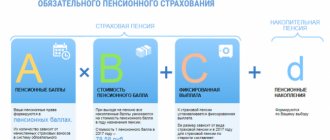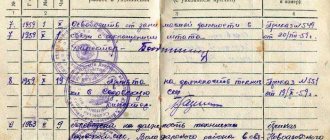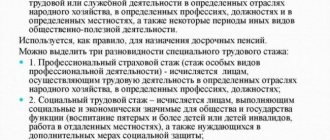At the beginning of 2015, the provisions of the pension reform came into force. From this moment on, the calculation of the pension is influenced by the length of the insurance period and the number of “pension points” accumulated during the period of working activity, the number of which is proportional to pension insurance contributions from the employee’s income. The law still allows an employee to retire due to old age earlier than upon reaching retirement age - for this it is necessary to have a special insurance period. Let's find out how the special insurance period is calculated.
What is special insurance experience?
Special insurance experience - the total duration of all periods of performance of official duties in hazardous production conditions (unfavorable, difficult), in harsh climatic zones, in areas with a special status.
In other words, we can say that special insurance experience is the time that a worker gave during his life, carrying out activities that are of particular importance for the country or associated with the negative impact on the body, health and life of the employee of psychological or physical stress, harmful production conditions , various dangerous factors.
We can talk about taking into account special insurance experience when the chosen type of activity meets special conditions, including:
- civil service under contract;
- specificity of certain types of work;
- special conditions for carrying out labor duties;
- carrying out work in the Far North or equivalent areas.
If an employee has special insurance experience, this fact gives him certain guarantees, namely:
- the right to receive an old-age pension before retirement age;
- the possibility of receiving payments for length of service (applies to military personnel and civilians equivalent to them).
What is included in the insurance period
2 groups of periods are counted in the insurance period:
- insurance;
- not insurance;
The difference between insurance periods and non-insurance periods is the calculation and payment of contributions to the Pension Fund. The legislation contains a closed list of such non-insurance periods:
- military service;
- receiving temporary disability benefits;
- the time specified for caring for each child until he reaches 1.5 years of age (only for one parent, chosen independently);
- the period of care provided by an able-bodied person for a group I disabled person, a disabled child, or a person who has reached the age of 80;
- for persons rehabilitated as a result of repression, or persons unjustifiably brought to criminal liability;
- the time of receiving unemployment benefits, participating in paid public works, moving or relocating in the direction of the state employment service to another area for employment;
- a period of cooperation as the main activity on the basis of a contract between citizens and bodies carrying out operational investigative activities.
In order to include non-insurance periods in the insurance period, a mandatory condition must be met: insurance periods must follow before or after such periods. The duration of labor or other activity does not play a role in this case.
In 2015, a mandatory condition for assigning an insurance pension is the presence of at least 6 years of insurance experience and 6.6 pension coefficients. Each subsequent year these figures will increase. According to the Pension Fund, by 2024 it will be necessary to have 15 years of insurance experience and 30 pension coefficients.
Calculation of special insurance experience: how it is determined
When calculating the duration of the special insurance period, the following periods of labor activity will be taken into account:
- creative work carried out in the state. institutions;
- work in state or municipal medical centers;
- teaching activities on children's profiles in municipal and state institutions;
- work as a geologist, topographer, etc. as part of various expeditions during research;
- work as a truck driver during mining (in quarries, open-pit mines, mines, mines, etc.);
- carrying out work in the subway or on railway tracks;
- in difficult conditions under the influence of certain factors (high temperatures, pressure, radiation, loud sound, vibration, etc.).
The concept of insurance experience
As a result of the reforms of the pension system, the insurance period is of decisive importance when assigning an old-age pension. It should be understood as contributions were made to the Pension Fund for a citizen, including a foreign state that is a participant in the compulsory pension insurance system
The obligation to pay them lies with the employer, who makes the corresponding transfers. Their size is 22% of the employee’s accrued wages.
Attention! Persons who, in accordance with the procedure established by law, have registered as individual entrepreneurs, as well as self-employed and privately practicing specialists, are required to transfer insurance premiums independently at the approved rates.
Thus, the insurance period can be taken into account only if deductions have been made. If, even if there is an officially registered employment relationship, no contributions were made to the Pension Fund, then this period of work is not included in the length of service.
How is it calculated
The insurance period is calculated by adding up the periods when insurance premiums were paid for a person. For the most part, this is the time of direct work or entrepreneurial activity.
However, we should separately highlight the so-called insurance periods, the correct calculation of which is of great importance for the corresponding calculation.
In accordance with the law, these must include:
- being on sick leave;
- caring for a child up to 1.5 years old;
- maternity leave;
- time to care for an elderly person.
This list is not complete or exhaustive.
Many older citizens are concerned about how their insurance coverage will be calculated for periods of work before 2002. This is due to the fact that such a thing as “insurance premiums” simply did not exist until that time.
However, these individuals need not worry as all these periods are taken into account by the pension fund. Payments under UTII and Unified Social Tax in the period from 1991 to 2002, as well as social insurance contributions before 1991, are equal to insurance contributions.
Implications for future pension
Changes in pension legislation, carried out as part of the corresponding reform, imply stricter requirements for recipients of insurance pensions. One of them is having a sufficient number of years of insurance experience. So, in 2021, the minimum number is 10.
If a citizen has worked for less time, then an insurance pension cannot be assigned to him.
The insurance period is not the only criterion for assigning an insurance pension . In this case, such a parameter as the individual pension coefficient (IPC), expressed in points, is also of great importance. In 2021 there should be at least 16.2.
Important! The IPC parameter affects not only the very fact of the possible assignment of a pension, but also the amount of future security.
How is experience confirmed when applying for a pension?
The Russian Pension Fund strives to reduce the level of paper document flow, including when interacting with insured persons, to a minimum. In this regard, since 2015, pensions are calculated based on information from an individual insurance account. They are contained in a single database of the Pension Fund.
A citizen has the right to access the relevant information by ordering an extract from the Pension Fund. In addition, you can find out about the account status in your personal account on the fund’s website.
However, in some cases, information about length of service in the Pension Fund database may be incomplete. In this case, entries in the work book are taken into account.
Calculation of special insurance experience: special positions and professions
There are no clear criteria by which one can say with certainty that a profession or position is “harmful”. However, the law prescribes focusing on the following indicators:
- the nature of the work performed;
- production conditions associated with exposure to harmful and life-threatening factors;
- service in the fire department;
- service in the penitentiary system;
- pedagogical activity;
- work in treatment institutions;
- performing work at an enterprise located in the Far North or similar areas.
Early assignment of pension for special service
At what age and under what conditions is early retirement available?
There is a list of professions divided by level of harmfulness into two lists. The first official list includes workers dealing with particularly difficult and dangerous working conditions. The second list included positions with less, but still difficult work.
Women who worked in positions designated in List 1 retire at the age of 45. They need at least 15 years of total experience, of which seven and a half were spent in hazardous work.
Women whose positions are listed in List 2 can receive a pension at the age of 50 years. The required general insurance experience is 20 years, half of which is special.
Male citizens who were formerly employed in List 1 positions can retire at the age of 50, having 10 years of special experience and twice as much general experience.
For men in Schedule 2 occupations, retirement is available at age 55.
In this case, you must have 25 years of experience, of which 12.5 will have special status.
Calculation of special insurance experience: special working conditions
Non-standard conditions for carrying out activities are considered:
- underground works;
- difficult and dangerous work;
- work in the field of mining production;
- work of high severity and intensity.
Back in 1991, the Government established a list of special working conditions, under which in some cases the retirement age is reduced by 5 years, in others by 10 years. The lists are still taken into account to this day.
Features of the use of special experience
In relation to each of the above types of special work experience, its own set of conditions must be met, the components of which, along with the mandatory presence of a minimum number of pension points, are:
- the age of the applicant for early retirement;
- the amount of total insurance experience;
- duration of work under special working conditions.
In this case, you should also focus on those approved by the Government of the Russian Federation (clause 2 and clause 5 of Article 30, clause 2 of Article 31 of the Law of the Russian Federation dated December 28, 2013 No. 400-FZ):
- lists of relevant positions, works and organizations, the procedure for establishing the correspondence of names when they change;
- rules for determining the duration of required periods of work;
- the procedure for assigning a pension, taking into account special working conditions.
Thus, the digital indicators of the conditions for applying special experience given in the description of each type of work must be formed according to the rules approved by the Government of the Russian Federation. The general approach to them, according to the text of the law of the Russian Federation dated December 28, 2013 No. 400-FZ, is characterized by the following:
- The retirement age can most often be reduced by 5 years, less often by 10 years.
- The usual difference in the required total insurance period for men and women is 5 years, taking a smaller value for women, which is due to the establishment of an earlier retirement age for them. But for some types of work the same length of service figures are indicated.
- For some types of work, special algorithms are provided for the influence of special length of service on reducing the retirement age.
- The harmfulness of work carried out after 2012 must be confirmed by the results of a special assessment of its conditions (clause 6 of Article 30 of the Law of the Russian Federation of December 28, 2013 No. 400-FZ).
- Its formation in the conditions of the Far North and equivalent regions can have a certain influence on the amount of special work experience (Article 33 of the Law of the Russian Federation of December 28, 2013 No. 400-FZ).
Special length of service formed before the entry into force of Russian Federation Law No. 400-FZ dated December 28, 2013 can be taken into account for the early assignment of a pension only if it gave the same right during the periods of its formation. Moreover, this can be done according to the rules of that period (clause 4 of Article 30 of the Law of the Russian Federation of December 28, 2013 No. 400-FZ).
For information about the rules for filling out the document, which is the main source of information about work experience, read the material “Instructions for filling out work books.”
How to calculate special insurance experience
Calculation of special insurance experience is carried out on a calendar basis. That is, 30 days of work under special conditions will be counted as a special month. length of service Months will then be converted to years. However, it should be remembered that there are conditions that must be met in order to qualify for special insurance coverage:
- income from activities must be paid to the Pension Fund;
- the work must be carried out during a full working day (if an employee works part-time, the duration of the shift is important, and for a full work shift, the actual time worked is taken into account);
- work that gives the right to special insurance coverage must be the main type of activity.
In addition to the time actually spent at the workplace, special experience includes:
- periods of temporary disability;
- basic annual leave with pay;
- additional rest time provided to employees working under special conditions.
What is the difference between work experience and insurance experience?
Although these two concepts may seem identical in meaning, there are important differences between them.
First of all, there is a significant difference in the calculation method. Thus, length of service takes into account only periods of work activity. The latter involves, for the most part, hired work. The insurance company takes into account all periods during which contributions were made to the pension fund. This also applies to business activities.
Secondly, insurance is used as one of the criteria for assigning a pension. References to labor in the current legislation are fragmentary. It is not taken into account when assigning pension benefits. At its core, seniority is a kind of legal rudiment.
Previously, in the legislation there was such a concept as “continuous work experience”. It should be understood as periods of constant work without significant breaks associated with dismissal. The amount of temporary disability benefits received directly depended on it. However, it was canceled back in 2006 as contrary to the Basic Law of the country, and therefore is not used in calculations at this time.
Despite the similarity of definitions, there are fundamental differences between labor and insurance types of length of service. The first is practically not used in the current conditions, while the value of the second is an important criterion for assigning pension benefits.
Legislative acts on the topic
| Federal Law of December 28, 2013 No. 400-FZ | About insurance pensions |
| Federal Law of December 15, 2001 No. 166-FZ | On state pension provision, on the importance of length of service when assigning pension benefits |
| Resolution of the USSR Cabinet of Ministers of January 26, 1991 No. 10 | On approval of lists of production work, professions, positions and indicators giving the right to preferential pension provision |
What is work experience
It should be understood as all periods when a person carried out labor activities. Until 2002, pensions were paid taking into account this indicator. Today, length of service is not actually used when assigning pension benefits. However, it can be taken into account when establishing various benefits, benefits, and so on.
Answers to common questions about calculating special insurance experience
Question No. 1: How to prove the presence of special experience if there are no entries in the work book?
Answer: Confirmation of the right to record special insurance experience, in addition to the work book, are employment agreements, extracts from places of work, certificates, and salary accounts.
Question No. 2: I was engaged in entrepreneurial activity, without having a certificate of registration as an individual entrepreneur. I worked under difficult conditions, which could have given me the right to take into account special insurance experience. How can I prove that I have the right to accrue special payments? length of service?
Answer: You will need to present a document confirming the transfer of insurance payments to the Social Insurance Fund employee.
How to calculate
The procedure for calculating the insurance period is regulated by Art. 13 Federal Law No. 400. It provides the following:
- calculation is made according to the calendar principle;
- self-employed citizens or citizens working under a contract with an individual accumulate experience if they have paid contributions to the Pension Fund;
- if a citizen has applied for a pension in another country, using certain periods of work, then in Russia these periods can no longer be applied;
- people who have length of service obtained before the 2015 changes have the right to decide how to calculate it - according to the new laws or the old ones.
Periods of work activity after the introduction of individual accounting and SNILS are subject to automatic confirmation based on the information recorded on the Russian’s personal account.
The calculation formula is elementary. All periods that can be counted as production are added up. The result obtained will be the insurance period.
Calculation example
Anna was officially employed for 20 years. During her working life, she gave birth to 2 children, with each of whom she was on maternity leave for 36 months.
After that, Anna became an individual entrepreneur and worked as an individual entrepreneur for 7 years. Moreover, out of these 7 years, she worked part-time for 2 years.
Its output will be calculated as follows:
- The work done while caring for a child is counted only for the first year and a half. During 2 maternity leaves, Anna accumulated 3 years of experience.
- If a person works part-time as an individual entrepreneur, the output is not counted, since there are no transfers to the Pension Fund.
- We sum up the difference of 20 and 3 with the difference of 7 and 2. The result is that Anna has accumulated 22 years of output.
The main document that confirms periods of work is still considered the work book. The information reflected in the document is checked by employees of the Pension Fund of the Russian Federation and taken into account when calculating length of service (if the employer made contributions to the Pension Fund). If a citizen meets the minimum length of service requirements, he is assigned an insurance pension, the amount of which depends on the length of work and earnings.








